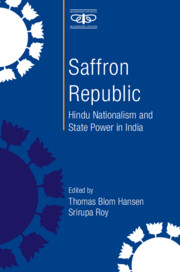6 - The Making of a Majoritarian Metropolis: Crowd Action, Public Order, and Communal Zoning in Calcutta
Published online by Cambridge University Press: 31 May 2022
Summary
Introduction
Throughout its colonial history, Calcutta had been a Hindu majority city at the heart of a Muslim majority province. Until the mid-twentieth century, despite the bitter rivalry, the city's Hindu and Muslim populations inhabited shared spaces even in neighbourhoods that had less than 10 per cent minority population. This character of the city began to transform in the inter-war decades, culminating in a decisive territorial marginalization and ghettoization of Muslims in Calcutta in the mid-twentieth century, following the Partition of India in 1947. At ‘the stroke of midnight’ on 15 August 1947, Calcutta emerged as the Hindu-majority capital city of the Hindu-majority state of West Bengal. The Partition and the streams of Hindu-Bengali refugee migration from East Pakistan transformed Calcutta into a ‘refugee city’ in successive decades.
The chapter tracks the ways in which Hindu–Muslim relationship unfolded in the city in the post-colonial era, which, I believe, continues to anticipate a politically self-conscious and coherent articulation of Hindutva in municipal politics in recent years. In many Indian cities, Hindutva over the decades has manifested as a powerful space maker which established majoritarianism as common sense. City dwellers have learned to identify and rationalize their belonging to the city in the context of this majoritarian urban common sense. In Calcutta, the normalization of the majoritarian city presupposes a foundational violence that annulled the earlier communal distribution of space and property between the majority and minority communities and introduced a new order of things. The ‘Muslim ghetto’ is the product of both the cleansing force of the civil war of 1946 and the rationality of the market process that maintained and reproduced communal stakes in the real estate transactions of the post-colonial city in subsequent decades.
In this chapter, I closely analyse a communal civil war in 1946 and a relatively minor communal outbreak in 1950, and relate these mobilizations with growing communal segregation in Calcutta in the subsequent decades. The chapter has three sections. The first section presents a close reading of an interrogation of a police officer by a high-powered enquiry commission in 1946–47 and unravels a rather complex spatial relationship between the city's Hindus and Muslims in the pre-Independence era.
- Type
- Chapter
- Information
- Saffron RepublicHindu Nationalism and State Power in India, pp. 130 - 157Publisher: Cambridge University PressPrint publication year: 2022

